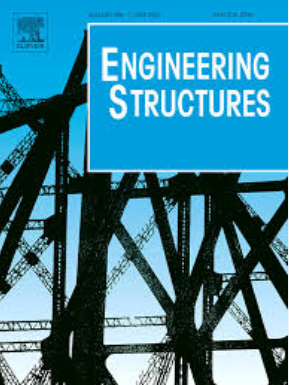Capacity-based inelastic displacement dual spectra for reinforced concrete bridges considering the basin effects
IF 5.6
1区 工程技术
Q1 ENGINEERING, CIVIL
引用次数: 0
Abstract
Structures at a sedimentary basin could suffer from amplified and prolonged ground shaking and severe damage under a strong earthquake, even though its epicenter is far from the construction site. In order to investigate the basin effects on the seismic response and damage accumulation of reinforced concrete bridges, the capacity-based inelastic displacement dual spectra that comprise an inelastic displacement ratio spectrum () and the corresponding damage index () spectrum were constructed specifically for the Taipei Basin. The computed dual spectra show very different spectral shapes between three seismic zones in the Taipei Basin, where the seismic zone I of the Taipei Basin has the largest spectral ordinates for the structural period () less than 1.8 s. It was found that as the longitudinal steel ratio of bridge columns increases, the would decrease, and on the contrary, the would increase. Meanwhile, the column aspect ratio was found to have minor influences on the computed dual spectra. Comparisons of the Taiwan code’s relation to the computed spectra indicate that the equal-energy principle could significantly underestimate the structures’ maximum inelastic displacement demand. In contrast, the factors suggested in FHWA and AASHTO specifications can provide a better estimation than the Taiwan code. Finally, the dual spectral formulae for the three seismic zones of the Taipei Basin were proposed, which can be applied to the damage-based seismic design and evaluation of reinforced concrete bridges.
考虑盆效应的钢筋混凝土桥梁基于容量的非弹性位移双谱
即使震中离建筑工地很远,沉积岩盆地的建筑物也可能遭受更大、更长时间的地面震动,并在强烈地震下遭受严重破坏。为了研究盆地对钢筋混凝土桥梁地震反应和损伤累积的影响,本文针对台北盆地,构建了基于承载力的非弹性位移双谱,包括非弹性位移比谱(CR)和相应的损伤指数谱(DI)。计算得到的双谱在台北盆地3个地震带之间的谱形差异很大,其中台北盆地I地震带构造周期(Tn)小于1.8 s的谱坐标最大。结果表明,随着桥柱纵钢比的增大,CR减小,DI增大。同时,柱宽高比对计算的双光谱影响较小。台湾规范的R−μ−Tn关系与计算的CR谱的比较表明,等能原理明显低估了结构的最大非弹性位移需求。相比之下,FHWA和AASHTO规范中建议的Rd因子可以提供比台湾规范更好的估计。最后,提出了台北盆地3个地震带的双谱公式,可用于基于损伤的钢筋混凝土桥梁抗震设计与评价。
本文章由计算机程序翻译,如有差异,请以英文原文为准。
求助全文
约1分钟内获得全文
求助全文
来源期刊

Engineering Structures
工程技术-工程:土木
CiteScore
10.20
自引率
14.50%
发文量
1385
审稿时长
67 days
期刊介绍:
Engineering Structures provides a forum for a broad blend of scientific and technical papers to reflect the evolving needs of the structural engineering and structural mechanics communities. Particularly welcome are contributions dealing with applications of structural engineering and mechanics principles in all areas of technology. The journal aspires to a broad and integrated coverage of the effects of dynamic loadings and of the modelling techniques whereby the structural response to these loadings may be computed.
The scope of Engineering Structures encompasses, but is not restricted to, the following areas: infrastructure engineering; earthquake engineering; structure-fluid-soil interaction; wind engineering; fire engineering; blast engineering; structural reliability/stability; life assessment/integrity; structural health monitoring; multi-hazard engineering; structural dynamics; optimization; expert systems; experimental modelling; performance-based design; multiscale analysis; value engineering.
Topics of interest include: tall buildings; innovative structures; environmentally responsive structures; bridges; stadiums; commercial and public buildings; transmission towers; television and telecommunication masts; foldable structures; cooling towers; plates and shells; suspension structures; protective structures; smart structures; nuclear reactors; dams; pressure vessels; pipelines; tunnels.
Engineering Structures also publishes review articles, short communications and discussions, book reviews, and a diary on international events related to any aspect of structural engineering.
 求助内容:
求助内容: 应助结果提醒方式:
应助结果提醒方式:


